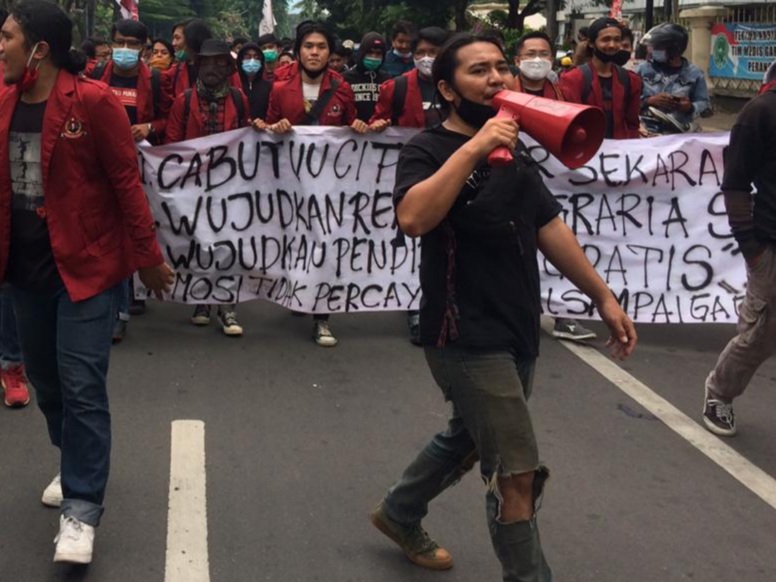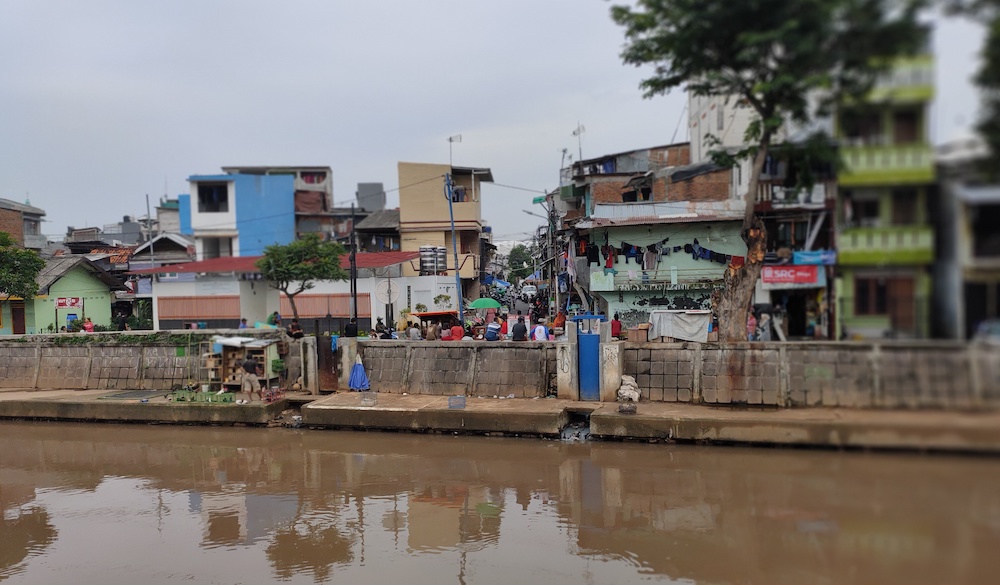On the evening of Oct. 8, Sandi Pulungan found himself hiding near an empty plot of land. The 29-year-old kept his head low, occasionally looking up to check his surroundings. At one point, he noticed riot police to the north pushing protesters back with tear gas. The protesters ran toward a settlement nearby.
Sandi joined what became part of nationwide protests that day, three days after the House of Representatives (DPR) approved the controversial Job Creation Bill. He and his friends marched to the iconic Tugu Tani statue in Central Jakarta in the morning, before protests descended into chaos in parts of Jakarta and other major cities in Indonesia.
By the afternoon, the protest turned into a riot. Police started dispersing the protesters, shooting tear gas as chaos took hold. Amid the directionless running of the protesters, Sandi took temporary refuge a few hundred meters east of Tugu Tani. He was separated from his friends and he was now all alone.
“I was on an empty plot land, it was a dead end. And across from the place I hid was Kwitang,” Sandi told Coconuts.
Kwitang is a Central Jakarta neighborhood comprising a varied demographic. There is elite housing there, but on the banks of Kwitang river, which flows along the west side of the neighborhood, there is also a slum.
To Jakarta’s Muslims, Kwitang is well known for its iconic mosque, Al-Riyadh, which was built by the nationally revered cleric Habib Ali bin Abdurrahman Alhabsyi, who was popularly known as Habib Kwitang. The cleric, who died at 98 in 1968, was known for his teachings of tolerance and harmony between human beings.
Coffee and fritters while you hide
“Over here, over here,” Sandi heard the residents of Kwitang calling to the protesters from the riverbanks.
Sandi ran towards them, jumping onto a concrete path on the side of the river before finding another footpath to cross. He saw seven other student protesters who had gone through this path, and they all went up some stairs leading up to the densely populated and crammed settlement.
The choice was either this, or probable brutal treatment at the hands of riot police.
Sandi saw around 100 protesters huddled in groups as they rested on a concrete road in the neighborhood. Upon seeing how selfless and hospitable Kwitang residents were, Sandi said he was filled with warmth.
“I saw protesters were welcome in almost every house. The residents served them tea, coffee, and fritters,” Sandi said.
For many protesters in Jakarta, Kwitang became their last hope at escaping violence, and the residents’ voices calling to them served as a beacon for safety from oppressive law enforcers.

The spontaneous help
Nia (20), a resident of Kwitang who wished to go by a pseudonym for safety reasons, was minding her dalgona street stall near the riverbank when the protesters began to pour into her neighborhood.
Knowing that the protest had escalated, she and her family decided to close the stall early to help the protesters. Nia rushed to her house, located on a narrow alley around 100 meters from the stall. It was a three-storey house, where she and 12 other family members live, which is a common set up in Jakarta slums.
With the help of her mother and aunt, Lia (40) and Ani (58), who also wished to go by pseudonyms, Nia boiled water for tea. The demand for a refreshing beverage was such that they made enough to be stored inside a keg. Ani also gave the protesters biscuits, which she noted were donated by the government as COVID-19 aid.
Nia also tended to protesters’ wounds and gave them medicine.
“Some of them were wounded, some even passed out,” she said.
Nia’s neighbors also joined in to help the protesters, ensuring that they were well-fed amid the exhaustion. None of the residents’ aid-giving was planned beforehand.
“It was a spontaneous act,” Nia said.
Kwitang turned into a safe refuge for some protesters who said they fled police brutality. Residents were again only too willing to help by offering them shelter, drinks, and food.
Nia’s neighbor, Ivan (56), who also wished to use a pseudonym, has lived in Kwitang for more than 30 years. He said that residents do not see the protesters as troublemakers, as he himself let some hide in a narrow alley in front of his house and served them water.
“They were just voicing their aspirations and we support it. It is not a big deal to give them water. It was all out of the blue and we did not want them to dehydrate,” Ivan said.
He added that he sympathizes with the protesters’ concerns regarding threats to workers’ rights from the Job Creation Bill, especially as his son was laid off due to cutbacks brought about by the pandemic.
“Many [Kwitang residents] are laborers, and some of them were laid off,” Asri, Ivan’s wife, chimed in.
Ivan said he had heard tragic stories of protesters becoming victims of police brutality in recent years, and he wanted to do his part to protect as many as he can.
Such generosity made protesters like Sandi feel at home, to the point that he felt bad about leaving the neighborhood.
“Every time, the residents asked me where I wanted to go,” Sandi said.
They suggested Sandi stay longer for his own safety, but he had to go find his friends. After learning that they had taken refuge at the nearby office of The Commission for Missing Persons and Victims of Violence (KontraS), the Kwitang residents directed him toward the safest route. He was relieved when he reached his destination unharmed.
Barbed wire can’t keep protesters out
The Jakarta Metro Police ended up arresting 1,192 protesters, and charged 167 of them for incitement of public disorder. On the other side of the coin, the Indonesian Legal Aid Foundation (YLBHI) found evidence of violent law enforcement against the protesters during and after the rally.
On Oct. 13, another protest against the Job Creation Bill was staged in Central Jakarta, this time with Islamic groups like Persaudaraan Alumni 212 (PA 212) and the Islamic Defenders Front (FPI) joining the rally.
Once again, Kwitang turned into a safe refuge for some protesters who said they fled police brutality. Residents were again only too willing to help by offering them shelter, drinks, and food.
Authorities appeared to begin noticing this pattern, as there were reports that neighborhood heads were summoned by the police and the army about closing off Kwitang during protests.
On Oct. 15, Jakarta Governor Anies Baswedan, along with Jakarta Military Commander Maj. Gen. Dudung Abdurrahman visited religious leader Habib Ali Abdurrahman Alhabsyi to discuss the safety of Kwitang residents. Two days before that, Central Jakarta Police Chief Heru Novianto apologized to residents for tear gas that was shot inside the settlement, as police officers chased protesters into the neighborhood, impacting some children in the area.
The meeting between the officials and residents was followed by police setting up barbed wire barriers at Kwitang’s access points in subsequent protests. During another rally on Oct. 20, Kwitang residents greeted student protesters and workers as if they were heroes fighting against social injustice.
In their own way, the residents defied what the barbed wire stood for, chanting, “we will open it,” to give protesters a way out if they needed one. Thankfully, they didn’t need one that day as the protest was carried out peacefully.
But one can be certain that no barbed wire will be able to keep those in need of protection away from Kwitang in the future.



